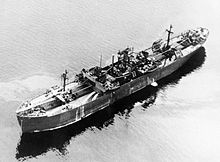CAM ship

CAM ships ( English : CAM ship = " C atapult A ircraft M erchantman" - in German about: "Katapult-Flugzeug-Handelsschiff") were modified British merchant ships from the Second World War that were equipped with a fighter plane on a catapult that could be started when there was a risk of an air attack. Due to the lack of escort aircraft carriers for air defense, CAM ships drove in convoys , but also regularly transported freight themselves. They were only used from August 1941 to May 1943 as a somewhat successful emergency solution. Of the 35 converted ships, 12 were sunk by enemy action. On the German side there were similar ships, so-called catapult ships and slingshot ships, which, however, were used to launch and supply long-range reconnaissance and sea rescue pilots and not fighter planes.
history
The name CAM was an acronym for "Catapult Aircraft Merchantman", in German about "Katapult-Flugzeug-Handelsschiff". A CAM ship was a vice rüstetes British merchant ship equipped with a rocket-propelled catapult - mostly on the front deck - equipped in order in case of enemy air attack on the open sea, a single Marine - fighter aircraft of the type Hawker Sea Hurricane in this version - Called “Hurricat” or “Catafighter” - to be able to take off to protect the convoy . Due to the lack of escort aircraft carriers, these ships traveled in convoys for air defense from summer 1941 onwards after being refitted, and they all continued to carry freight as well.
The carried fighter was there lack of landing facilities a loss device , as it could not land back on the merchant vessel and no seaplane was would have been brought to the use on board again and again can be used. The pilot therefore had to either jump with the parachute after the flight or after the fuel had been used up or dive in with the machine (in order to be fished out of the water himself afterwards), while the Sea Hurricane then sank into the sea. It is therefore advisable to use the aircraft on board with caution or to only start them in acute danger.
Due to the missions over the open sea and the limited fuel supply of the specialized on-board aircraft , landing on distant land bases was usually not an alternative or was almost always unrealistic anyway.

The main purpose of the CAM ships was to act as a threat or response to the Focke-Wulf Fw 200 Condor long-range reconnaissance aircraft flown by the German Air Force , which shadowed the convoy and their position via radio to submarines or during the Atlantic Battle other aviation personnel reported - but not infrequently also attacked with bombs or on-board weapons . CAM ships were mainly used on convoy routes in the North Atlantic , but a little later also in the Mediterranean on the Gibraltar route and in the Arctic Ocean or in arctic waters against northern convoys .
A total of 35 merchant ships were to CAM ships converted, from the Michael E . Some of the ships were requisitioned by civil shipping companies, others were commissioned by the British Admiralty as Empire ships . Nevertheless, due to their operational character, they must be viewed as military ships and they were also operated as such. The CAM ships - although they rarely started their fighters - had a certain deterrent effect on attackers, even if nothing comparable to a MAC ship or even a full-fledged aircraft carrier .
The first four of these ships were in the service of the Royal Navy to as "auxiliary Jagdflugzeug- catapult ships " (Auxiliary Fighter Catapult Ships). Units converted later were manned by regular merchant navy crews . The planes were flown by pilots from the specially trained Merchant Ship Fighter Unit , which was stationed at RAF Speke airfield near Liverpool .
At the end of each trip, the pilots were catapulted into the air with their planes to land on a nearby airfield and to stay in practice. In the two years of operation, a total of only nine catapult launches for combat missions were carried out, with eight enemy aircraft being shot down in the loss of an RAF pilot and eight own aircraft being lost. Of the total of 35 CAM ships deployed, 12 were sunk by enemy action, mostly by aerial bombs and / or submarine attacks.
In the end, the CAM ships were only a somewhat successful emergency solution in Great Britain's early war years, they were replaced by new and much more powerful escort aircraft carriers from late 1942 .
Individual evidence
- ↑ Archive link ( Memento of the original dated August 12, 2007 in the Internet Archive ) Info: The archive link was inserted automatically and has not yet been checked. Please check the original and archive link according to the instructions and then remove this notice.
See also
- Atlantic battle
- Seaplane carrier
- MAC ship (merchant aircraft carrier)
- Auxiliary cruiser
- List of historical aircraft carriers